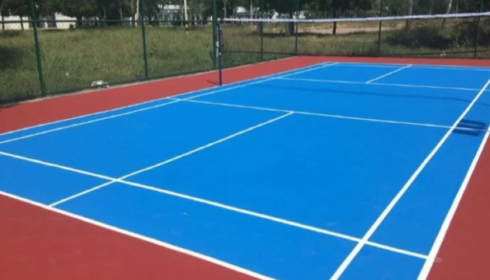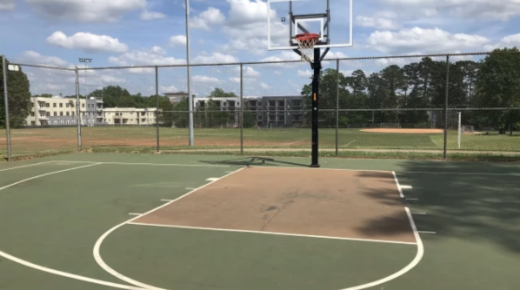
badminton court flooring
Badminton has grown into a global sport with intense demand for quality facilities that cater to both professionals and enthusiasts. In India, the rise in academies, schools, and indoor stadiums has led to a surge in demand for tournament-standard badminton court flooring. If you’re planning to build or upgrade a court, understanding the right materials and standards is critical. This guide explores the flooring specifications approved by the Badminton World Federation (BWF), the key materials used in tournament courts, and how to ensure your facility is up to par.
Importance of Flooring in Tournament Badminton Courts
The floor is one of the most critical components of a badminton court, especially when designed for tournaments. It directly influences player performance, safety, and the court’s longevity. Unlike casual courts, professional tournament courts must adhere to strict regulations for shock absorption, surface friction, and bounce uniformity.
Proper flooring not only helps prevent injuries but also ensures a consistent playing experience for athletes. A good badminton floor must be resilient, non-slip, and able to withstand the pressure of rapid, repetitive footwork. It also must be adaptable to the Indian climate if installed in different parts of the country.
BWF-Approved Flooring Specifications
The Badminton World Federation (BWF) provides a detailed framework for badminton court construction. For tournaments and certified play, the flooring must comply with certain dimensions, materials, and technical features:
Court Size:
- Total court dimensions (doubles): 13.4 meters x 6.1 meters
- Recommended run-off area: 2 meters on all sides for safe play
Floor Properties:
- Shock Absorption: Reduces player fatigue and injuries
- Slip Resistance: Ensures grip without being too sticky
- Ball Bounce: Surface must provide predictable shuttle bounce (mostly affects serve and net play)
- Surface Color: Generally green or blue with white/yellow line markings
BWF Certified Flooring:
- Materials must be listed under BWF’s certified equipment manufacturers (especially for international tournaments)
- PVC and PU surfaces are commonly accepted when they meet performance standards
Key Materials Used in Tournament Badminton Court Flooring
Choosing the right badminton court flooring material ensures compliance with tournament norms and provides a professional playing surface. Let’s explore the most preferred materials:
1. PVC Vinyl Sports Flooring
Overview: This is the most commonly used flooring for professional indoor badminton courts across India. Available in mats, rolls, or tiles, PVC vinyl provides a cushioned and anti-skid surface.
Benefits:
- BWF-compliant options available
- High shock absorption
- Easy to install and maintain
- Moisture and humidity resistant
Installation: Usually installed over a level concrete or wooden base with adhesive. Comes in 4–8 mm thickness variants.
Cost: ₹500 – ₹850 per sq. meter
Best for: Schools, academies, sports centers, and BWF-approved tournaments
2. PU (Polyurethane) Sports Flooring
Overview: PU flooring is a high-performance, seamless solution ideal for multi-sport indoor arenas. It’s durable, slip-resistant, and has excellent cushioning.
Benefits:
- Long lifespan (8–12 years with proper care)
- Seamless surface – no joints or seams
- UV-stable (if needed in partially open areas)
Installation: Applied as a liquid over prepared concrete, forming a flexible, cushioned layer
Cost: ₹650 – ₹1200 per sq. meter
Best for: Professional multi-use facilities and stadiums hosting national-level tournaments
3. Wooden Flooring with Vinyl Overlay
Overview: Wooden sports flooring (typically maple or teak) is used in elite and international tournament settings. A vinyl surface may be added for anti-skid and aesthetic purposes.
Benefits:
- Excellent resilience and comfort
- Superior shuttle response and bounce
- Premium look and feel
Installation: Requires sub-floor system with shock absorption pads and leveling
Cost: ₹1500 – ₹2500 per sq. meter
Best for: International tournaments, premium clubs, Olympic-level venues
Surface Layer and Line Marking
In tournaments, accurate and durable line markings are critical. These are typically done with high-visibility, anti-skid PU or epoxy paints. The markings should contrast clearly with the surface color (usually white or yellow) and must be of precise dimensions:
- Line Width: 40 mm
- Short Service Line: 1.98 m from the net
- Long Service Line: 5.88 m from the net (singles)
- Net Height: 1.55 m at the edges, 1.524 m at the center
These details ensure players, referees, and spectators can clearly interpret gameplay.
Tips for Choosing the Right Flooring for Tournament Use
- Choose Certified Materials: Always verify that the flooring material is BWF-approved if your facility is used for official competitions.
- Prioritize Shock Absorption: Players jump and land frequently — poor flooring increases injury risk.
- Consider Climate Conditions: PU and PVC are both resistant to humidity, making them ideal for Indian conditions.
- Ease of Maintenance: Look for surfaces that can be easily cleaned and don’t require frequent recoating.
- Consult a Professional Installer: Proper installation affects surface performance more than the material itself.
Budgeting for Tournament-Level Flooring
When planning a professional badminton court, the cost can vary depending on the surface material, installation method, and support accessories. Here’s a rough breakdown:
| Flooring Type | Estimated Cost (INR/sq. m) | Court Size (sq. m) | Total Cost Estimate (INR) |
| PVC Vinyl Flooring | ₹500 – ₹850 | ~82 sq. m | ₹40,000 – ₹70,000 |
| PU Sports Flooring | ₹650 – ₹1200 | ~82 sq. m | ₹53,000 – ₹1,00,000 |
| Wooden with Vinyl Overlay | ₹1500 – ₹2500 | ~82 sq. m | ₹1,20,000 – ₹2,00,000 |
Final Thoughts
Designing a tournament-level badminton court is an investment in performance, safety, and professionalism. With a clear understanding of BWF-approved specs, choosing from materials like PVC vinyl, PU, or wooden flooring, and budgeting wisely, you can create a world-class facility.
Whether you’re developing a school court or a national-level stadium, the right flooring ensures your players enjoy consistency, speed, and comfort every time they step onto the court.
For the best results, always work with experienced flooring suppliers who offer warranties, certifications, and installation support tailored to your specific needs.

